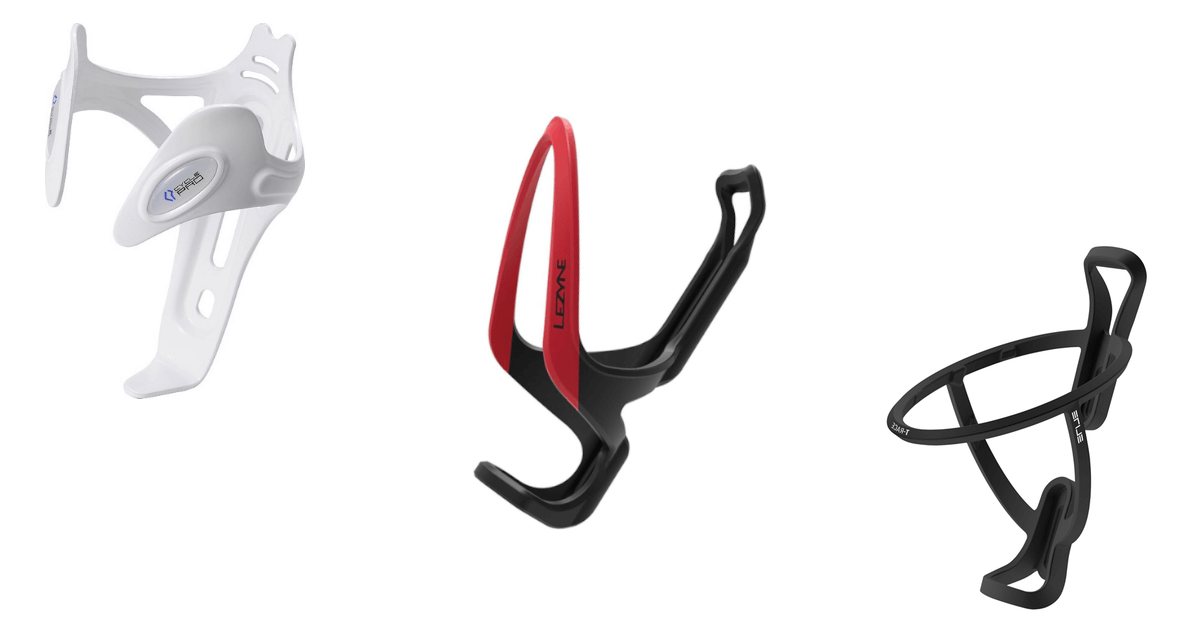Material
The most important factor when choosing a bottle cage is the material.
Common bottle cages are made of steel, aluminum, or plastic, but race-oriented bottle cages are also available in carbon fiber.
Aluminum bottle cages are heavier and tend to have less flexibility in accommodating bottle sizes, which can be a drawback.
Plastic cages are lightweight and come in various shapes, offering more options at affordable prices. However, they may not fit all bottles perfectly and are more prone to damage in case of crashes or contact.
The highest-grade bottle cages are made of carbon fiber. Their main advantages are lightweight and strength, but they are significantly more expensive. If weight is your only concern, a plastic bottle cage can be light enough, so there’s no need to go for a pricey carbon model unless you want the absolute best.
Size
Size is the trickiest part when choosing a bottle cage.
While most manufacturers design their cages to fit standard cycling water bottles, there are subtle size differences between brands and models. As a result, it’s not uncommon to buy a bottle cage only to find your existing bottle doesn’t fit.
If you want to ensure compatibility, it’s best to check the fit in person at a store before purchasing. Alternatively, choose an open-style bottle cage. These cages offer some flexibility and can accommodate slight differences in bottle size—typically a few millimeters.
That said, open-style cages made of plastic may accumulate stress and eventually break over time. For better durability, opting for a carbon fiber cage is a safer choice.
Shape
When it comes to usability, the shape of the bottle cage is surprisingly important.
As you browse different bottle cages, you’ll notice variations such as:
- Whether the holding section extends from the bottom or the side
- Whether the cage is open or enclosed
- Whether bottles are inserted from the center or from the left/right
These differences can affect how easy it is to insert and remove your bottle, as well as how securely it fits. This is especially important in races or other situations where you can’t afford to waste time grabbing your drink.
Some products even allow you to adjust the cage size with bolts. If you use a plastic bottle for daily rides and a cycling bottle for long rides, a cage with an adjustable fit can be especially convenient.
Color
Color is one of the key points people care about when choosing a bottle cage.
Some match the bottle cage to the bike’s overall color, while others use it as an accent with a contrasting color. Matching it with bar tape or outer cable color can also be a fun way to coordinate your bike.
One thing to watch out for is that plastic bottle cages often look slightly different in photos than in real life. You might think you’re getting a pure white cage, only to find it’s actually slightly bluish. Or a vibrant yellow might turn out to be duller than expected. If you’re particular about the color, it’s best to check the actual product in person.
Mounting Area
For bikes with a front derailleur, pay special attention to where the bottle cage is mounted.
If the front derailleur uses a band clamp (rather than a direct mount), the clamp can interfere with the bolts that secure the bottle cage on the seat tube.
If the bottle cage sits above the derailleur band, you’re fine. However, in many cases, the band ends up right between the two bottle cage bolts, causing interference.
If this happens, you can insert a spacer to raise the bottle cage slightly. If you don’t have a proper spacer, a regular washer from a hardware store will do the trick.
